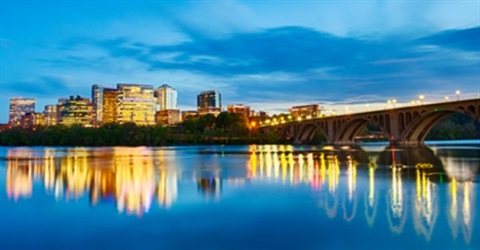Trends that Shaped A Decade: Diversification of Arlington Economy
February 19, 2020 | By Sarah Van Velsor

The 2010s brought significant change to Arlington’s economy. Arlington began the decade bracing for the impact of a mass relocation of federal offices and workers from the County. Arlington’s commercial vacancy rate peaked at 20.4% in 2015, as we felt the full effects of the 2005 Base Realignment and Closure Commission (BRAC), which called for the U.S. Department of Defense (DoD) to relocate 17,000 jobs from Arlington County. We ended the decade on a high note with Amazon building a new headquarters in Pentagon and Crystal City, bringing at least 25,000 new jobs over the next 10 years. Between these two capstone events, years of careful planning, a strong economic development strategy and lots of hard work set the stage for creating an innovation economy that appealed to a Fortune 5 tech giant.
As Arlington Economic Development (AED) embarks on a new decade, it is timely to look back at six trends that contributed to the transformation of Arlington’s economy and positioned us for success in the future. We will share these trends across multiple blog posts and will cross-link them as they are posted.
- Planning and Placemaking
- Diversification of Arlington Economy and Growth of Entrepreneurial Ecosystem
A major priority after BRAC was to diversify Arlington’s economy to include high tech, consulting, headquarters and high-growth startups. Over-reliance on the federal government put Arlington in a vulnerable economic position. Economic development efforts focused on making Arlington an attractive place for corporate headquarters, high-growth start-ups, and other tech businesses.
The first big win of the decade was Boeing’s decision to consolidate and expand its DC metro offices in Crystal City with construction starting in 2011. Other major headquarters announcements also played a big role in diversifying Arlington’s economy including CEB (now Gartner) announcing an expanded new headquarters at Central Place in Rosslyn in 2014, German grocer Lidl announcing that its U.S. headquarters would be located in Crystal City in 2015 and the Nestlé headquarters announcement in 2017. Startups founded in Arlington also fueled growth in the 2010s with Ballston-based Applied Predictive Technologies (now Mastercard) and Opower (now Oracle) both rapidly expanding their footprint in Arlington. Federal innovation leader DARPA moved into a new headquarters in Ballston in 2012.
In addition to these big headquarters, Arlington is home to more than 16 coworking and shared office spaces to support our growing startup ecosystem. Some notable openings in the past decade were SPACES in Rosslyn and TechSpace in Ballston. These coworking spaces give early-stage startups a place to work and network to grow their business.
Arlington also launched a Gazelle Grant program in 2017, offering incentives up to $150,000 for high-growth tech startups to locate to Arlington. This program encourages companies with high-growth potential to sign a lease for at least three years in Arlington. Initial recipients of the grant include Axios, Higher Logic, Phone2Action and VideoBlocks.